13 Minutes
Mazda’s Quiet Climb Toward Premium
The 2025 Mazda CX-60 PHEV arrives with subtle updates but a clear ambition: to challenge premium crossovers by offering a refined interior, engaging driving dynamics, and a punchy plug-in hybrid drivetrain. Our test car — a fully loaded Takumi Plus specification — demonstrates that Mazda’s Large Product Group strategy is more than marketing spin. This mid-size SUV may not appear radical on paper, but it’s a convincing package for buyers who want near-luxury quality without the obvious badge of a Lexus or German premium brand.
Heritage and First Impressions
I’ve been following Mazda for years. Early models like the CX-7 and the second-generation Mazda6 shaped my appreciation for the brand’s focus on driving feel and design. The CX-5 continued that tradition, and now the CX-60 takes Mazda into a new tier — larger, more composed, and positioned to compete with premium rivals in Europe, Japan, and Australia. (Note: the CX-60 is not offered in North America; there the CX-70 and CX-90 fill similar roles.)
This was my first time behind the wheel of a CX-60, a model introduced in 2022 as part of Mazda’s “Large Product Group.” On the road, it communicates the marque’s intent: sophisticated looks, refined cabin, and driving dynamics aimed at enthusiasts who also prioritize practicality.
Design Evaluation: A Refined Take on Kodo
Mazda’s Kodo design language evolves here into something that reads expensive and dignified. The CX-60’s proportions — a long hood, set-back cabin, and muscular hips — create a silhouette that feels both retro and modern. Everything visually works: the expansive grille, the narrow headlights, the sculpted surfaces.
Photo: Sorin Stefan/autoevolution
There are few direct comparisons in the segment. The Genesis GV70/GV80 hint at similar cues, but Mazda’s execution is leaner and more minimalist. The Jaguar F-Pace may be the nearest analog, but even that has a shorter front overhang. From front 90-degree shots to rear three-quarter views, the CX-60 consistently impresses with a design that avoids the generic.
Our Takumi Plus test car is among the best-equipped variants. Standout exterior specification items include Matrix LED headlights, body-color mirrors, a piano-black grille, LED taillights, a power-operated liftgate, a black roof spoiler, and 20-inch diamond-cut alloy wheels. The optional Soul Red Crystal paint (a €1,050 option) looks striking, though red is a personal taste call. A new Zircon Sand color for 2025 is a tasteful alternative.
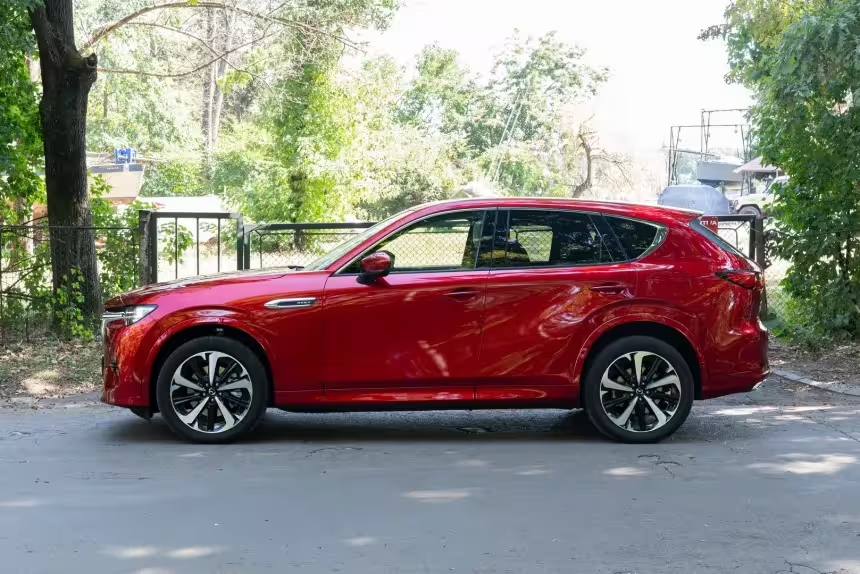
Interior: Minimalist Luxury and Practical Details
Photo: Sorin Stefan/autoevolution
Step inside and the CX-60 delivers a minimalist, almost Scandinavian-inspired cabin. Our car used white Nappa leather (power-adjustable, heated and ventilated), but a new all-black Nappa leather option is available for this model year. The dashboard is clean, accented by tasteful wood trim and a white fabric material that breaks up the veneer. Door panels carry a refined look—some elements even recall Volvo’s restrained styling—and that’s a compliment.
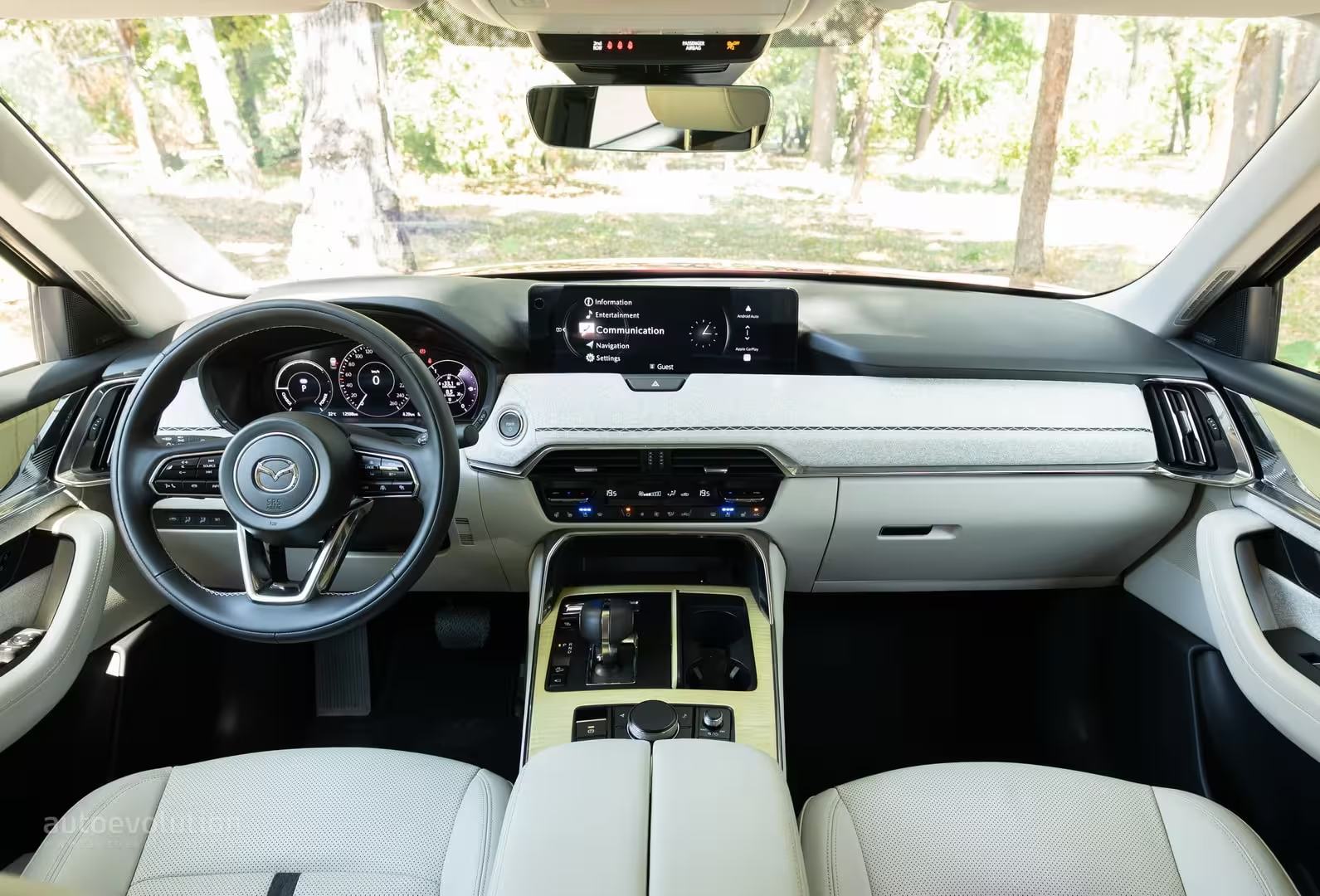
Equipment highlights include wireless charging, a 12-speaker Bose audio system, automatic climate control, ambient lighting, a power-adjustable steering column, and generous digital screens: a 12.3-inch instrument cluster and a 12.3-inch infotainment display with Apple CarPlay and Android Auto. A head-up display and a wide array of active safety systems add to the impression of a near-luxury package.
Rear-seat space is sensible for a family of four or five. The CX-60 is not a 7-seater, but it offers real practicality: 20.1 cu.ft (570 liters) of trunk volume with the rear seats up, expanding to 61 cu.ft (1,726 liters) with seats folded. Notably, the PHEV layout does not compromise luggage space — a point many plug-in hybrids fail to match.
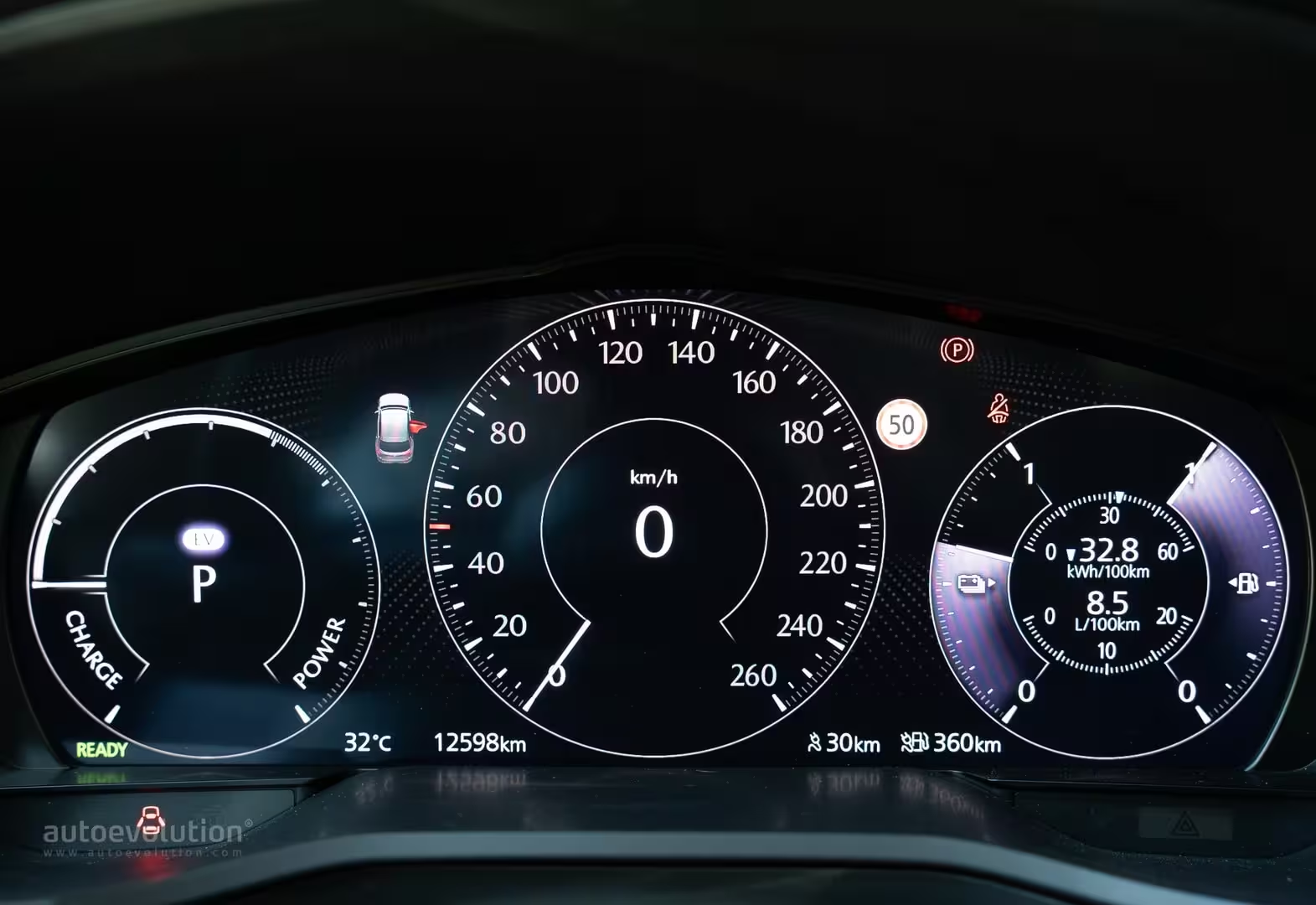
Specifications — Key Figures and Powertrain
Drivetrain and Performance
The CX-60 PHEV combines a 2.5-liter naturally aspirated inline-four gasoline engine with a high-output electric motor and a 17.8 kWh battery pack. The gasoline unit produces 191 hp while the electric motor contributes roughly 175 hp, yielding a combined system output of 323 hp (327 PS). Mazda quotes a 0–60 mph time of about 5.8 seconds, which aligns with how the car feels in everyday driving: brisk, confident, and responsive when you ask for it.
What’s unusual in today’s market is the choice of a naturally aspirated engine rather than a turbocharged unit. Mazda favors a high-compression, straightforward gasoline engine paired with a large electric motor. The philosophy is mechanical simplicity, linear power delivery, and long-term reliability — a trade-off that shows both strengths and limits in fuel economy and mid-range surge.
Chassis and Handling
For 2025 Mazda revised the suspension geometry, upgraded the dampers, reworked the power steering tuning, and updated the 8-speed automatic transmission software. The result is improved on-center feel and a more composed ride without sacrificing Mazda’s characteristic engagement. The CX-60 holds the road with confidence; it never feels skittish, and it rewards enthusiastic driving with predictable responses. Nevertheless, the vehicle’s size and long hood provide a sense of scale you can’t ignore — this Mazda behaves like a larger SUV even if it’s more nimble than its appearance suggests.
On the Road: Driving Impressions
In daily driving the CX-60 PHEV is a pleasingly quick SUV. The electric motor delivers strong initial acceleration and the combined output makes overtakes effortless. However, because the internal combustion engine is naturally aspirated, the delivery can feel somewhat choppy at lower throttle openings. Switching to Sport mode tightens the response and smooths power delivery for more satisfying progress when you want to drive briskly.
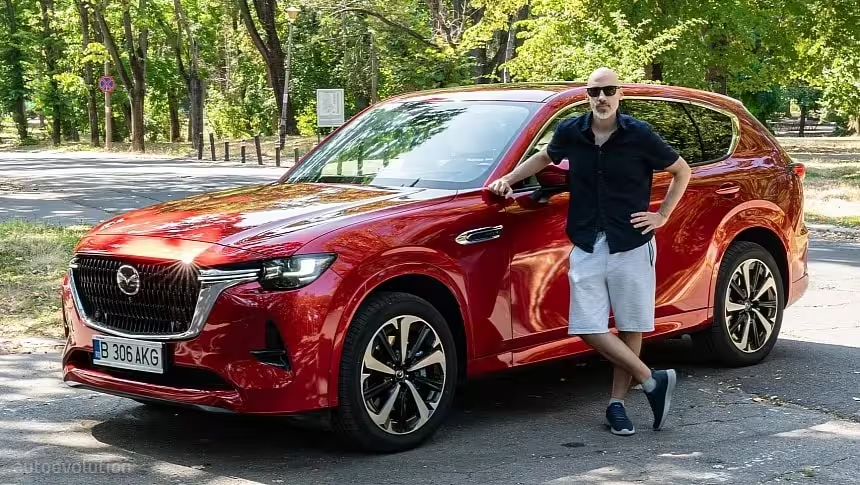
One characteristic to note: the gasoline engine can sound louder than its real-world thrust suggests, especially in Normal mode. The exhaust note is engaging and sporty, but the car’s real-world pace depends on both the ICE and electric assist — you won’t get 323 hp from just one source.
The 8-speed automatic shifts smoothly for the most part. At times, the gearbox’s behavior betrays the complexity of coordinating two power sources, but the software updates for 2025 have reduced hesitation and improved shift logic. Steering is tuned to feel communicative, and the turning circle is surprisingly manageable for a vehicle in this class, though the long dash-to-axle ratio may take a day or two to get used to when parking or negotiating tight urban spaces.
Efficiency and Everyday Range
When driven as an electric vehicle, the CX-60 PHEV performs well: smooth, silent, and capable of covering reasonable daily commutes on battery power alone. The 17.8 kWh battery is on the generous side for a PHEV, and urban drivers who regularly charge at home will find it easy to keep most short trips emission-free.
However, the gasoline engine’s naturally aspirated character limits fuel economy on longer runs. In a mixed test that included highway driving, our best observed consumption was around 8.5 L/100 km (approximately 27.7 mpg). That’s not poor for a performance-focused PHEV of this size, but it’s not especially frugal either. Once the ICE is engaged for extended cruising, fuel consumption climbs compared with some turbocharged or more range-optimized PHEVs.
Market Positioning and Pricing
Mazda positions the CX-60 as an upscale alternative to mainstream crossovers. In Europe it competes with the Lexus NX (notably the 450h hybrid variant), the Jaguar F-Pace, and certain higher-spec German models. The CX-60 offers a blend of interior quality, driving engagement, and tech that puts it within striking distance of premium rivals, but it undercuts many of them on price when similarly equipped.
A fully equipped CX-60 2.5 E-SKYACTIV PHEV in Takumi Plus trim with the Soul Red Crystal paint option is roughly €65,000 in Europe (taxes included). In the UK, expect prices around £55,000. These figures are competitive for the class but represent a meaningful investment — buyers will weigh package, brand prestige, and ownership costs when deciding.
Comparisons: Lexus, Jaguar, BMW
If you’re considering a Lexus NX 450h, the CX-60 is a credible alternative: similar price territory, more interior room in the Mazda, and a driving experience that favors engagement over outright plushness. The Lexus may feel more refined in NVH (noise, vibration, harshness) and long-distance calm, but the Mazda is more entertaining and arguably offers better value for the equipment.
Against the Jaguar F-Pace, the CX-60’s styling and dynamics are comparable. Jaguar leans into sportier handling in some trims, while Mazda aims for a balanced drive that blends comfort and control. A BMW X5 sits above the CX-60 in size and dynamic polish, but the Mazda still impresses for its design and cabin quality given the price gap.
Practicality: Who Should Buy It?
The CX-60 suits buyers who want near-premium interior quality and an engaging driver’s car that doesn’t sacrifice family practicality. It’s ideal for those who will use electric range for daily commuting and appreciate the reassurance of a dependable gasoline engine for long trips. If you need a true 7-seater or maximum towing capacity, look elsewhere (CX-90 in North America or larger rivals). If your primary goal is to minimize fuel costs on extended motorway runs, some diesel or hybrid setups may be more efficient.
What I Liked and What I Didn’t
Pros
- Strong overall performance and combined system output of 323 hp that feels quick in everyday driving.
- High-quality interior materials and minimalist, premium design that rival near-luxury brands.
- Practical luggage space that isn’t compromised by the PHEV battery layout.
Cons
- Fuel efficiency is unremarkable on highway runs once the ICE is engaged.
- The naturally aspirated engine can be noisy and sometimes gives an impression of greater performance than delivered across the rev range.
Final Verdict: A Proof of Concept for Mazda’s Premium Ambitions
Photo: Sorin Stefan/autoevolution
The 2025 Mazda CX-60 PHEV is more than an incremental update; it’s a signal that Mazda can build SUVs that squarely address premium-minded buyers. The Takumi Plus specification we tested demonstrates strong interior quality, engaging dynamics, and a thoughtfully executed plug-in hybrid system. The vehicle is not flawless — fuel economy and some NVH aspects leave room for improvement — but it’s a compelling alternative to rivals such as the Lexus NX and Jaguar F-Pace.
Would I buy the PHEV? For many buyers the answer will depend on usage patterns. Urban drivers who can charge regularly will love the electric-first driving experience. Buyers focused on long-distance economy might prefer diesel or alternative hybrid layouts. Personally, I’m intrigued by Mazda’s direction: the CX-60 feels like a statement car — one that proves Mazda can play with the big names while keeping driving enjoyment and design at the heart of the package.
Specifications Summary
- Model: 2025 Mazda CX-60 2.5 E-SKYACTIV PHEV (Takumi Plus)
- Engine: 2.5L naturally aspirated inline-four
- Electric motor: High-output motor paired with 17.8 kWh battery
- Combined power: 323 hp (327 PS)
- 0–60 mph: approx. 5.8 seconds
- Trunk volume: 20.1 cu.ft (570 liters) with seats up / 61 cu.ft (1,726 liters) with seats folded
- Notable features: Matrix LED headlights, 12.3-inch instrument cluster, 12.3-inch infotainment screen, Bose 12-speaker audio, wireless charging, head-up display
- Price (approx.): €65,000 in Europe (Takumi Plus, incl. Soul Red Crystal), £55,000 in the UK
Recommendation
If you want a mid-size SUV with premium touches, solid performance, and a refined cabin, the Mazda CX-60 PHEV deserves a test drive. Its character leans toward drivers who want engagement and style rather than purely optimized efficiency figures. For buyers comparing premium compact crossovers, the CX-60 is a persuasive alternative, particularly if you value design, build quality, and a driver-focused chassis. If maximum fuel economy or full seven-seat flexibility are top priorities, consider other models in Mazda’s lineup or competitors with those specific strengths.
Overall, the Mazda CX-60 PHEV is a well-rounded, thoughtfully executed SUV that points clearly to Mazda’s capability to compete in the premium segment — if not to dethrone the established luxury names, then certainly to offer a compelling, more characterful choice.
Source: autoevolution

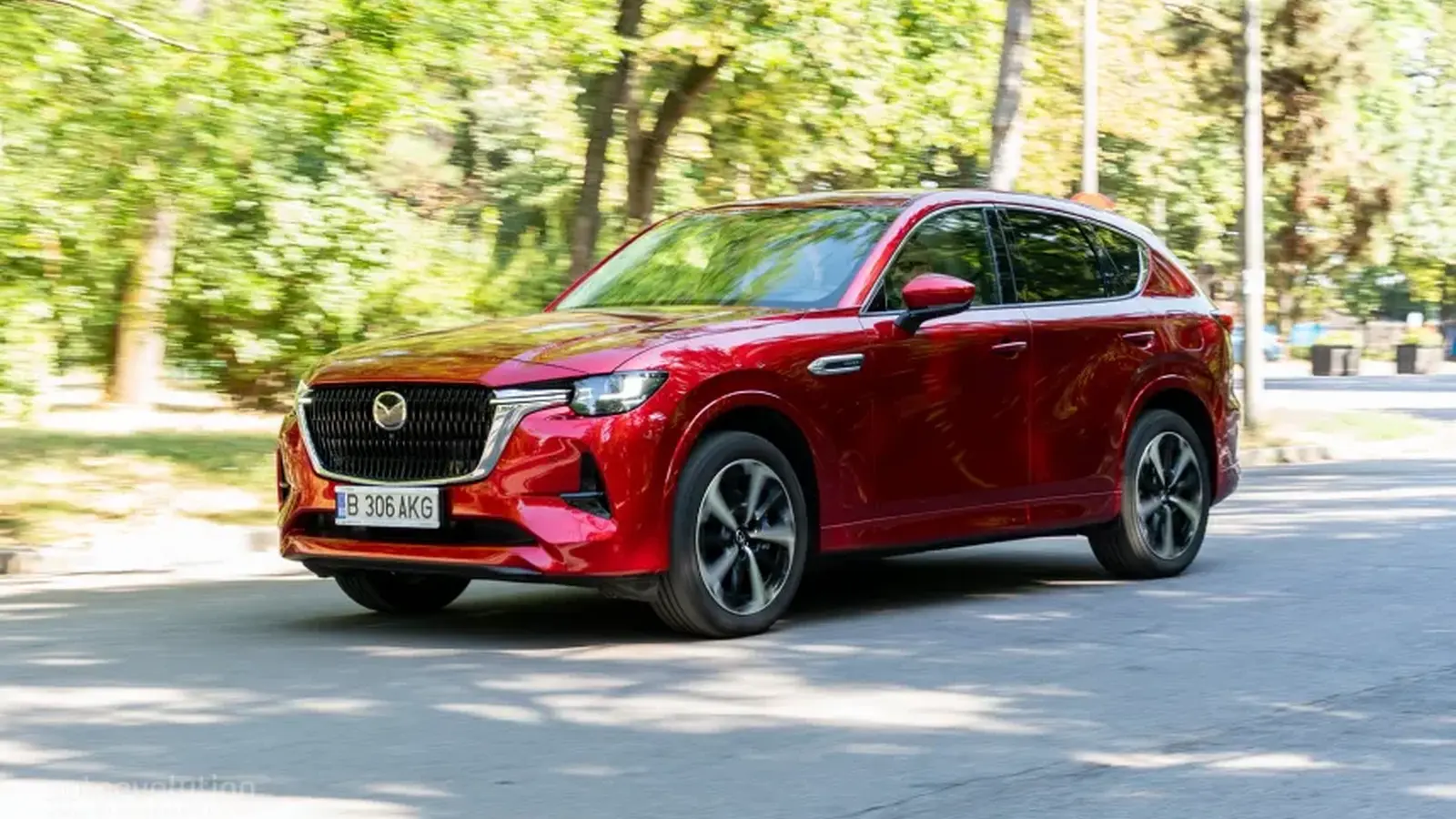
Leave a Comment